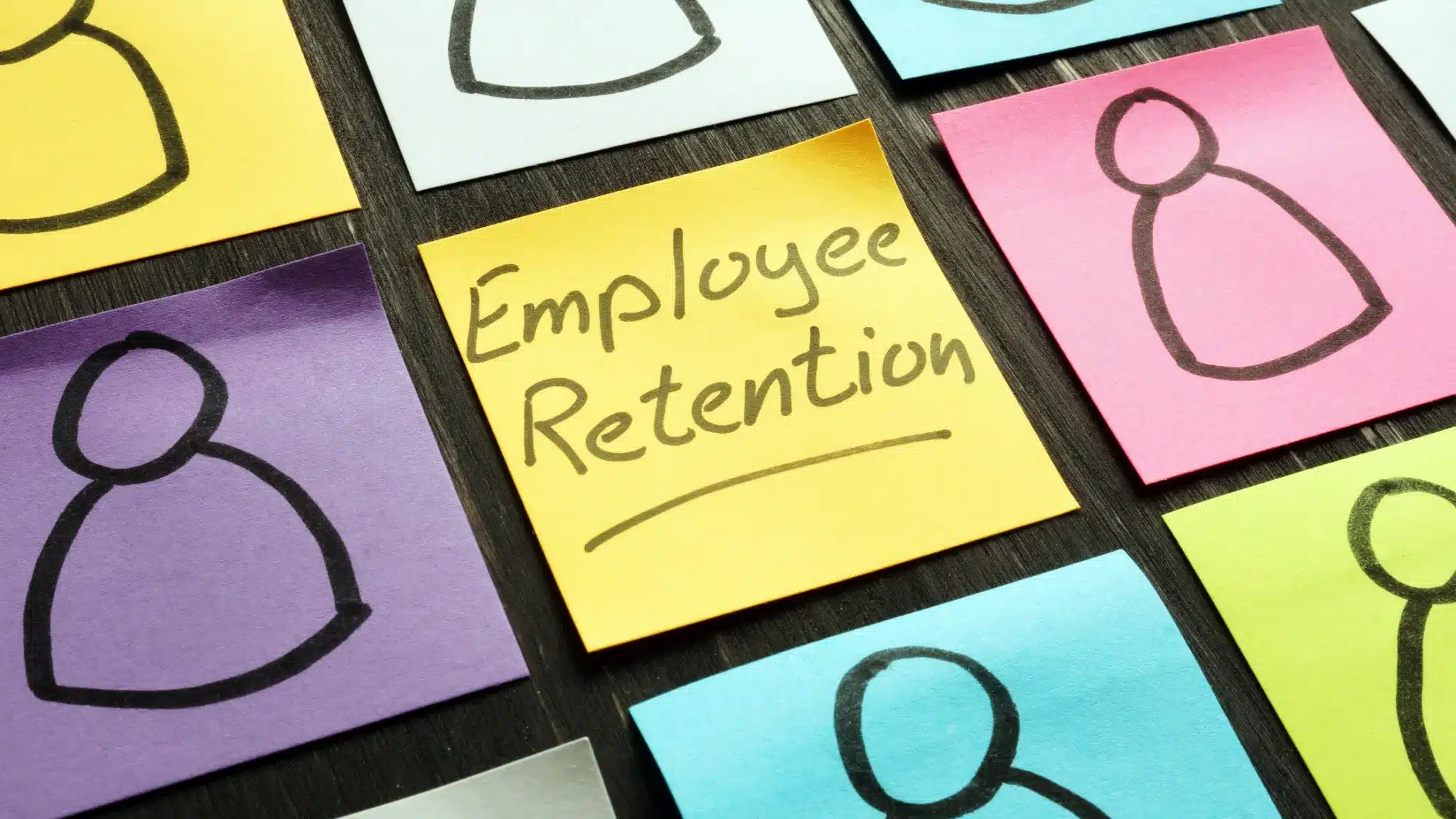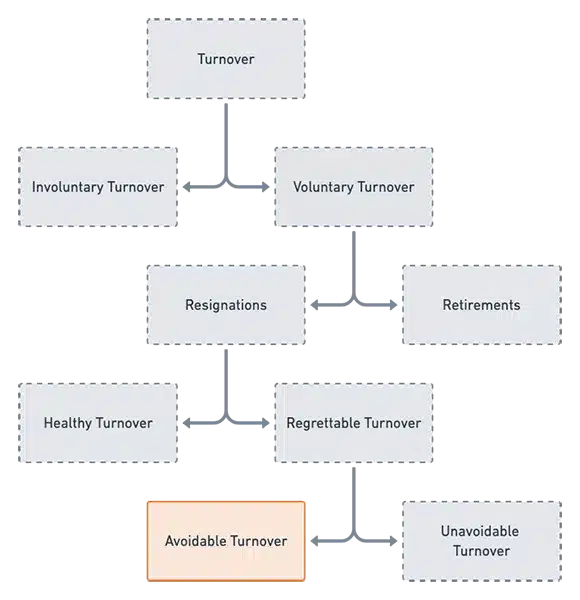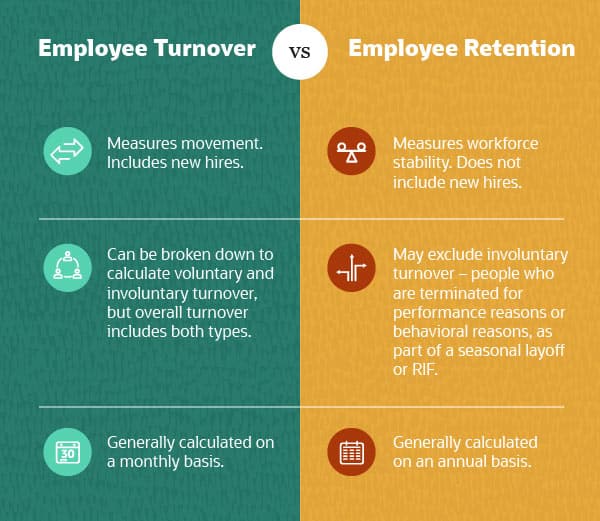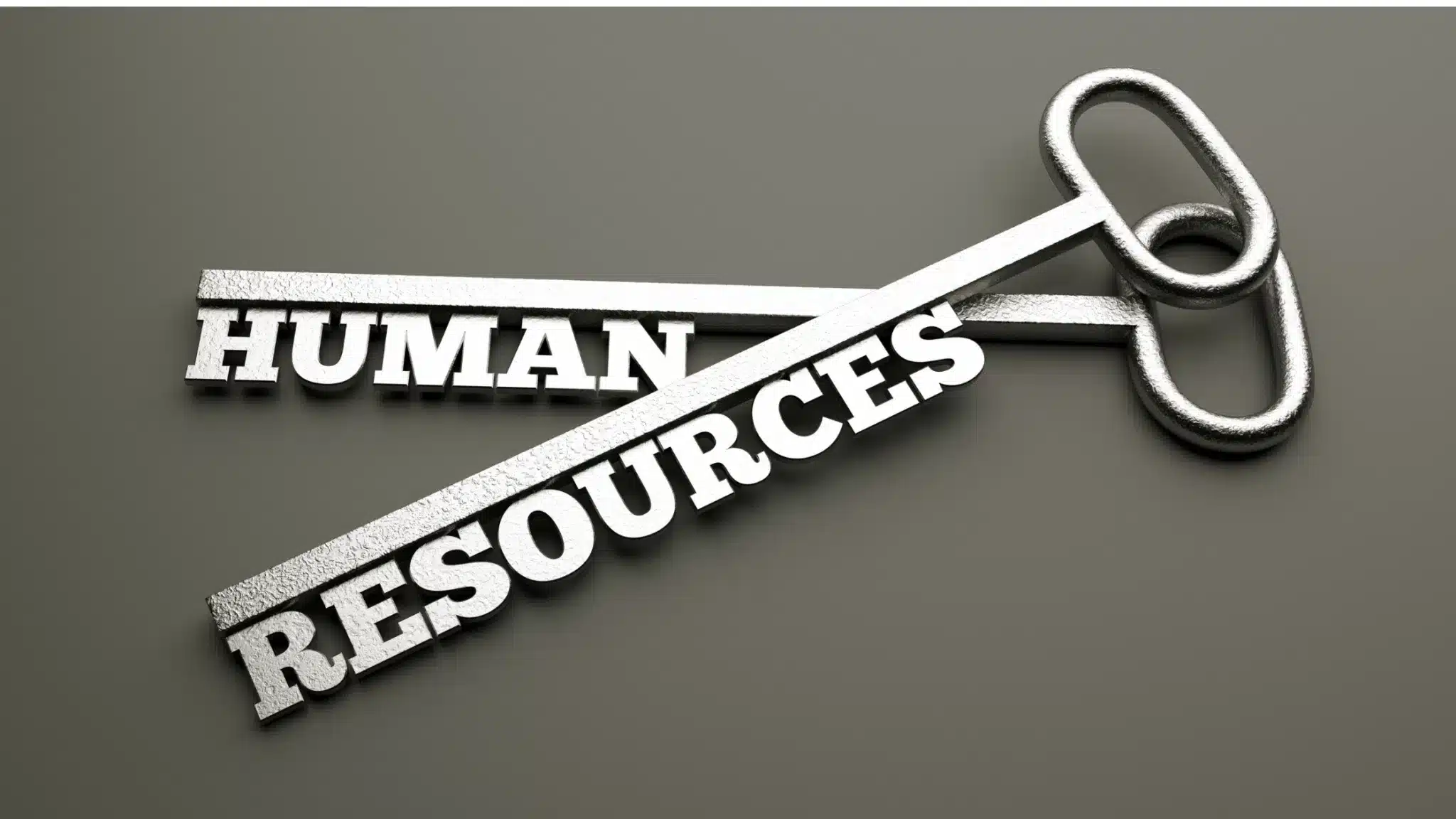
Has Employee retention become a major concern for your organization?
Is it now affecting every facet of your organization including employee morale, engagement, performance, service/product quality, revenue, and the company’s overall growth? A few of your top performers have already left. And a few others are ready to resign. And you are baffled about how to fix the situation.”
Here’s a comprehensive guide to help you jack up employee retention in your organization in 2025-
What does employee retention mean?
Employee Retention refers to the policies and processes involved in making employees stick to your organization for a longer tenure.
It can be expressed as your organization’s ability to retain top talents. It is an attempt to make your qualified and committed employees stay with your organization.
Employee retention includes policies regarding compensation, employee engagement, performance, recognition, hiring, etc.
Employee retention has become a matter of concern for most HRs especially with the heightened competition for talent in the market and the increasing “job-hopping” nature among employees.
In an SHRM survey, 47% of HR professionals mentioned Retention/turnover as the top workforce management challenge. A report predicted employee turnover ‘tsunami’ in 2021-22. According to the report about quarter of workers will quit their jobs once COVID-19 pandemic reduces.
Employee retention for remote work

The remote workforce has become the new trend post-pandemic. In recent research, almost 30% of remote workers said that they’d quit their current job if they weren’t allowed to continue work remotely.
If you are still reluctant to adopt remote or hybrid work in your organization, you might have to pay the price in form of higher employee turnover.
A survey shows that 1 out of 3 workers will seek a new job if asked to return to offices for full-time. On the other hand, companies that let their teams work from home, have a 25% lower employee turnover rate.
Are retention rates and Turnover rates the same thing?
Retention rates and Turnover rates are two opposite terms. Employee turnover is the proportion of your employees who quit the job over a specific period. Terms like attrition and churn are sometimes used alternatively to refer to employee turnover.
And Retention is the proportion of employees who stay and the strategies employed to make them stick.
“Employee turnover is a situation where employees exit the organization voluntarily for various reasons or are relieved by the organization or retire, thereby affecting the organization, most times negatively in terms of costs and the capacity to deliver the minimum required services.”-Gary Corcoran of Advance Systems.

Types of Employee turnover
Voluntary turnover
It refers to when employees decide to leave the job. The primary focus of the employee retention program is to understand and reduce this type of employee turnover rate.
The average turnover rate across all industries is around 18%, the average turnover rate for the IT industry however is over 13.2%.
Involuntary Turnover
It refers to when the organization asks an employee to leave. It is important to understand that some employee turnover is desirable for example, in a situation where the employee is a poor fit for the post. Such turnover can be termed as healthy or functional turnover.

Source:https://bonus.ly/employee-retention-guide/what-is-employee-turnover-retention
Look at the following infographic to understand the key differences between retention rates and turnover rates-

The cost of employee turnover
One of the most terrible mistakes an HR can do is keeping employee retention on the backburner. “I can always hire a new employee as a replacement.” If HRs go on with this attitude, it can cost them time, finances, resources, and output.
Look at the following points to understand “how”-
1 It’s expensive
The cost of losing an employee is much more than it appears on the surface. According to an SHRM report, on average a company loses 6 to 9 (50-70%) months of an employee’s salary to replace him or her.
For example, if an employee is making $60,000 per year, then the company will have to bear a replacement cost of around $30,000 – $45,000. And say 10 employees are terminating per year, then it will cost you around $3,00,000 – $4,50,000 a year.
Another research shows that replacing each hourly worker can cost your organization an average of $1,500. According to Gallup, the loss businesses incur by employee turnover is approximately $1 trillion a year.
Still, finding these numbers hard to believe?
Here is another data that shows the cost of employee turnover in 2018 and 2020 were $600 billion and $680 billion respectively.
These numbers clearly show how the costs of hiring, onboarding, long-term training, and reduced productivity can take a gigantic bite out of your organization’s overall budget. Which makes the effort you put into employee retention truly worth it.
2 Time-consuming
Apart from being costly, the whole process of hiring, onboarding, and training is time-consuming. According to reports, the time spent on hiring across all industries is 3-4 weeks on average.
Even after hiring, the employee takes some time to become fully efficient and learn his role. Therefore, if your organization has a high turnover rate, the number of inexperienced employees will be higher and productivity and output will decrease significantly.
3 Creates disruption
When an employee leaves the organization, the unspoken negativity can be felt throughout the organization. There is a productivity and knowledge loss as the person you thought to be most deserving for the post is no longer there.
“Labour turnover results in an organization’s inability to ensure knowledge continuity.”-Urbancová Hana and Linhartová Lucie
When an employee will leave your organization, other employees will be forced to do overtime to fill the gap until a new hire is appointed. Which often leads to burnout and may prompt them to quit, making things worse for your organization.
What are the benefits of employee retention?
Employee retention not only reduces the loss caused by employee turnover, but it can also benefit your organization in a number of metrics such as-
- Increased employee happiness.
- Increased Productivity
- Improved company culture
- Better employee experience
- Better customer experience
- Increased employee morale
- Increased revenue
- Reduced acquisition and training cost as well as time.
How is employee retention measured?
Employee Retention Rate is calculated with the following formula-
Retention Rate = (Number of employees who stayed for the specific time period / Number of Employees at the start of the time period) x 100
In excel you can calculate it as-

Let’s understand with an example-
If you had 250 employees on April 1, 2020, and the number has reduced to 230 employees on 31 March 2021.
The retention rate for the year will be- 230/250*100= 92%
Does your company have a good employee retention rate?

What can you consider as a healthy employee retention rate? The answer is subjective. Let’s understand with the above example itself.
If the 8% of employees who left the organization in the above example are your top talents then your company will suffer a considerable amount of loss. But if the employees who left were mostly inefficient, the loss incurred will be much lesser.
But generally speaking, if the employee retention rate is 90 percent or above, it is considered to be good.
What factors affect employee retention?
Retention is a multidimensional concept. Employees never leave an organization without a reason.HR teams are responsible to probe into the cause and intervene immediately to find measures to retain them accordingly.

Let’s look at the following examples to understand how different factors of turnover impacts your retention rate-
Example 1: Immediate Manager
Lisa was a talented employee. She was motivated, innovative, and hard-working. Her works lacked errors. She had always been one of the top performers. But her immediate manager never got along with her. She soon got fed up and decided to leave the job.
According to Gallup data, at least 75% of employees voluntarily turnover because of their managers.
Example 2: Poor fit to the job
Consider an employee who is contributing very little to your organization. He/ She is mostly unmotivated and has no real sense of connection with His/Her colleagues. He/she has no sense of commitment or belonging towards the organization. He is waiting for an opportunity to leave the company.
When such an employee decides to leave the company, this turnover may actually benefit your organization as his replacement will be more productive and bring more value to the organization.
Example 3: Pay and benefits.
Say an employee is working at your organization with a static salary of $20000 a year for the last two years. If he/she is offered a job that will pay him $30000 a year with added perks like flexibility, development opportunities, etc. He/she is most likely to leave the job in that case.
Did you know? According to Robert Half, 38% of employees leave their jobs because of “inadequate salary and benefits.”
In another survey, 35% of workers say they’ll quit if they don’t get a raise.
Example 4: Underappreciation
Martha is a hard-working employee. She gives her best in every project. The last project she was in charge of was a huge success. But her work is hardly recognized. She hasn’t been promoted in the last 4 years. She doesn’t see a future for herself in the organization anymore. With frustration, she has decided to quit the job.
“ 24% of employees who had not received recognition from their direct supervisor in the past two weeks had recently interviewed for another position”
Example 5: Onboarding and Training
Now consider an employee who has recently joined the organization and is now going through a training period. He is not clear about his role in the organization yet. His experience of the first few days at your organization was not that pleasing. He is detached from his colleagues and is finding him out of place. He finally decides to leave the job even before the training period ends.
Example 6:Lack of development opportunities
Greg has been working in a company for the last 6 years. But now he is in a stagnant position in terms of career and personal development. He doesn’t see any opportunity at the current company and has decided to seek out growth opportunities elsewhere.
Example 7: No Flexibility
Martha has a toddler to take care of. She wants to work from home often to take care of her baby without hampering her career. But the organization she is working for doesn’t offer the flexibility of work schedule. She is, therefore, looking for another job that will allow her to work remotely.
Example 8: Lack of Work-life balance and wellbeing
The past 7-8 months have been hectic for Sam. The increased work pressure in the organization he is working in has started affecting his physical as well as mental health. His work-life balance has been affected due to the overtime and his family-life has started crippling down. There are evident signs of burnout. He has recently started looking for another job to get his life back on track.
What are the 5 main drivers of employee retention?
As seen above, the 5 Pillars of employee retention can be pointed out as-
- Workplace flexibility
- Employee benefits
- Career development
- Good manager-employee relationship
- Employee experience and fulfilment.
How can HR retain employees?

Do you want to stop your employees from leaving? The easiest way to do so is to have a strategy to make them stay.
A report by Work Institute covering 250,000+ employees, suggests that more than one in three workers will voluntarily quit their job every year by 2023.
Here is a list of employee retention strategies that can play a vital role in both attracting and retaining top employees in your organization-
1 Start with a killer Onboarding process
Onboarding is the first interaction with your new hires. It is also one of the most impactful ways in which you can address employee turnover in your organization.
With a great onboarding experience, 9 percent of employees are more likely to stay with a company for at least the first three years. However, imagine you losing your employees within 2-3 months of hiring because of a bad onboarding process.
A survey shows that only 12% of employees think that their organization is doing a good job with onboarding. In another survey, only 47 % of respondents stated that their onboarding program effectively retained new employees.
Here are a few tips to make your onboarding process more efficient and set the tone of employee experience from day one-
- Provide them with a buddy for the initial days
- Leverage technology to fire up your onboarding process.
- Introduce them to your benefits and wellness programs
- Help them understand their roles and developmental possibilities
- Acquaint them with company culture.
2 Invest in employee growth opportunities
Developing your team members is not an optional perk to offer but your key responsibility. According to a LinkedIn report, 93% of employees would stay longer at a company that invests in their careers.
If you don’t provide your employees’ training and development opportunities to continually update their skills, they are more likely to leave. 70% of employees would leave their current job to work in an organization known for investing in employee development and learning.
Here are a few things you can do to help your people keep developing and learning-
a. Offer bite-sized learning: The most common complaint employees have is they don’t get the time to learn. Offer microlearning as a solution. it costs more to hire and train someone who leaves than it costs to develop them and have them stay and be productive” – Mike Warren, founder, and CEO of Alethia Strategic Business Solutions.
b. Create on-the-job learning opportunities: Classroom-style learning is outdated. Provide your employees with on-the-job learning experiences that would serve the worker’s unique needs and challenges.
For example, if an employee is lacking collaborative skills, use this as an opportunity to create their ‘unique learning experience’.
c. Provide educational assistance: The Cigna Corporation, for example, invested millions of dollars in tuition assistance. A report on their ‘educational benefits program’ from 2012 to 2014 revealed that they noticed a 129 percent return on investment. Because they could avoid the talent management costs.
You can also take inspiration from Walmarts. They have partnered with leading universities in the U.S. to support employees in their educational endeavours.
3 Create an inclusive culture
With the recent shift towards creating Hybrid and remote teams, diversity has been achieved in most organizations. But do all these diverse people in your team feel included?
Did you know? 3 in 5 workers experiencing workplace discrimination. A study by Arizona State University further reveals that corporations are losing more women and minority professionals than their male and white counterparts.
“If you don’t create the conditions for people to stay, you can do an amazing job at hiring and then people aren’t going to stay,” – Diego Scotti.
A culture of inclusion can positively impact the creativity, productivity, and innovation in your organization. 67% of job seekers consider inclusion and diversity while choosing a job.
Tips to foster inclusion in your organization-
- Make communication a priority.
- Identify the under-represented groups and their needs
- Train managers and leaders to create a safe space for your employees.
- Provide equal opportunities for all of your employees.
- Encouraging teammates to interact
- Encourage collaboration
Leading companies like Accenture also focus on creating a culture of diversity and inclusion with the belief that “As equals, anything is possible.”
4 Listen to employee feedback
When you give your employees feedback, you help them develop themselves and their performance.
In return, your employees stay happy, engaged, productive, and loyal to your organization. Feedbacks help employees understand their part in the organization and create a sense of belonging.
A Gallup study consisting of 65,672 employees, found that employees who received feedback on their strengths had 14.9% lower turnover rates than for employees who received no feedback.
Annual and quarterly performance reviews are not enough for this purpose. Create a feedback loop with regular check-ins and surveys.
It is also important to develop a Feedback system that flows two ways.It will give them a voice to share their employee experience. And help you understand the drawbacks.
Remember, Feedbacks only give you insights into what needs to be done, you need to take action to make the change happen.
Here are a few ways to collect quality feedback from your employees:
- Anonymous Feedbacks
- Regular employee performance reviews
- One-on-one meetings with managers
- Exit interviews etc.
5 Invest in employee relationship
Help your managers be a mentor. To maintain and improve employee retention, it’s important that your leaders, managers, and front-line supervisors understand their workforce.
61% of employees say trust between themselves and senior management is very important to job satisfaction.
As an HR, you should facilitate the right training to help them effectively communicate with the employees. Listen to your employees and let them feel heard.
Lytx, for example, maintains a healthy employee relation through investing in collaboration tools, a spacious on-site café, dry-cleaning services, etc.
6 Reward and recognition
In a survey, 68 percent of respondents said that their organization’s recognition program positively affects retention.
Recognition has a direct impact on employee retention along with engagement and employee satisfaction.
Have a recognition program in place and publically appreciate your employees for their achievements.
Employees whose managers consistently acknowledge them for good work can reduce turnover up to 31%. (Source)
You can adopt different forms of rewards to recognize your employees such as financial compensation, additional perks, Professional recognition, etc.
Several companies have a recognition program in place to curb turnover and ensure retention. Apple, for example, has a reward system tailored to meet regional, cultural, and personal requirements.
Apple decided to offer paid holidays for three days in a row in thanksgiving. While workers in a different location and culture would be given paid time off during an equivalent holiday.
7 Flexible work arrangements
Flexibility not only gives employees the chance to work wherever and whenever they want but also helps organizations to attract and retain employees.
In a research, it is found that nearly a third of workers were looking for a new job because of the lack of flexible work opportunities in their current workplace. HubSpot for example has witnessed the direct impact of their flexible work environment through both the hard work of employees and their positive feedback.
It’s your turn now. Let your employees work when and where it works best for them and see the change in performance and retention.
8 Employee wellbeing
Employee wellbeing has now become a boardroom priority. In a study, 53 percent of respondents considered employee wellbeing to be a major factor in whether they stayed or quit a job.
Although Employees who have a higher work-life balance are 10% more likely to stay at their company.
Human resource leaders admit employee burnout is affecting workforce retention causing 50% turnover. Organizations that invest in employee wellbeing- both mental and physical, have seen a rise in productivity, employee morale, work-life balance. All this ultimately contributes to higher retention.
Take the example of Siemens, a company that has its own employee-led flexibility (ELF) policy to accommodate all of its employee needs.
Netflix on the other hand has had an unlimited vacation policy since 2010. It lets employees simply “take a vacation” with no rules to recharge and refuel.
9 Keep them engaged
Gallup’s research shows that “engaged and thriving” employees are 59% less likely to look for a new job in the next 12 months. This data clearly speaks about how important employee engagement is to retain your top talents.
Here are a few things you can do to increase engagement levels at your organization-
- Get your leaders engaged in their teams
- Know their pulse
- Foster communication and transparency
- Offer autonomy
- Appreciate the job well done
- Create an innovative culture etc.
John Lewis for example keeps their employees engaged by empowering them. They call their employees partners and involve their partners in decisions and encourage them to take personal responsibility.
10 Employee satisfaction and experience
77% of companies focus on employee experience to increase retention. While another survey found that 81% of job seekers cited dissatisfaction as the primary reason why they are searching for a new job.
Right from onboarding, it is important that you create a unique employee experience that will attract and retain your employees. Specific employee experience programs and strategies can help you create 3x higher profit apart from the cost saved in retention.
Below are few actionable steps to help you increase employee experience and satisfaction in your organization-
- Start with a good onboarding process.
- Take feedbacks
- Organize team-building activities.
- Provide support and guidance
- Foster company culture.
Bonus Tip: It’s always better to initiate the preservation process when your employees are still in love with your organization, not when they are fed up and ready to quit.
What Employee retention tools do you need?

Here are 5 employee retention tools you need to make a kickass employee retention program-
1 Recruiting and hiring tools
Employee Turnover begins with a poor hiring process.
If you hire an inefficient person, he/ she is destined to leave the job within a short period of time either voluntarily or involuntarily.
A Recruiting and hiring tool can help you, analyze candidates, more precisely and 2x faster.
2 Performance evaluation tool
It will help you benchmark your goals and evaluate employee performance.
With Performance tools, you can guide your teams for personal and professional growth with an increased sense of accountability and purpose.
3 Employee survey tool
Employee survey tools will help you enter the heart of your employees. It will give you insights into the unique needs and requirements of each team member.
You will also be able to take action on data-driven analytics to improve the retention rate of your organization.
4 Rewards and recognition tool
You need recognition software to keep the motivation and engagement in your organization intact.
These tools also provide a space for peer-to-peer recognition, fostering workplace relationships -a significant factor of employee retention.
5 Engagement tool
Engagement tools can help you get real-time insights into people & culture to monitor the growth of people as well as business.
You will be able to compare your engagement reports with competitors, run engagement surveys, and organize more structured 1:1s.
Why is Peoplebox the best solution?
- Feedbacks and Surveys won’t be nerve-wracking anymore with its automated surveys.
- Anonymous feedback and messaging will help you provide employees a safe space to honestly share their concerns.
- OKRs and engagement insights to understand employee engagement like never before and get data-driven analytics
- Coffee Connect to help your remote employee build connections with colleagues and teammates.
- Coaching and 1:1 to encourage and assist managers in people management.








